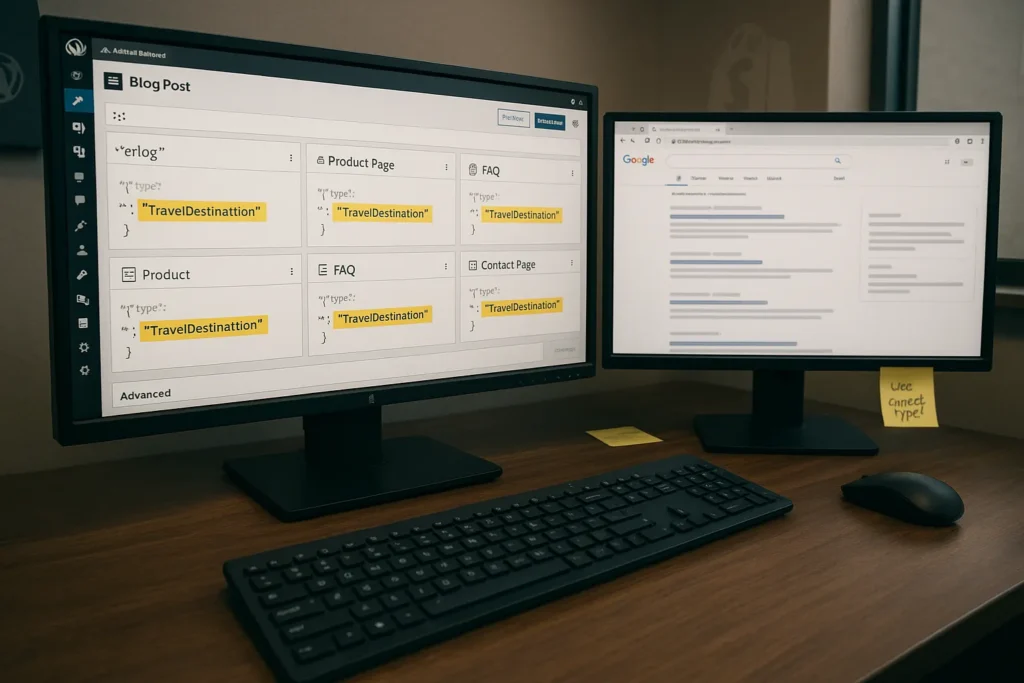Friday
30 May5 Common Schema Markup Mistakes That Hurt Your SEO
It’s frustrating when you are struggling to climb the search rankings even though your content’s solid and your site ticks all the right boxes. Recent data shows that around 96% of web pages never get a single visit from Google search results. And one overlooked culprit for it is faulty or missing schema markup.
Schema is the behind-the-scenes code that helps search engines understand what your page is about. If you do it right, it can win you rich results, boost click-through rates, and even push your rankings up. But if done incorrectly… Well, that’s where most folks go wrong without even realising it.
In this post, we’re looking at five common structured data mistakes that could be sabotaging your schema SEO. We’ll walk you through what to watch for, how to fix it, and a few technical SEO tips that’ll make a visible difference. Let’s get into it.
Mistake #1: Using the Wrong Schema Type
Using the wrong schema means assigning structured data that doesn’t accurately reflect what’s actually on the page. It can lead to big missed opportunities in search. Sometimes people think that all schema types are the same. However, it’s a false idea.
Let’s say you’re running a blog. If you tag your post as a WebPage instead of an Article, you’re telling Google, “This is just a generic page,” not the rich, time-stamped content it actually is. That small mismatch means you’re less likely to show up in carousels or get those clickable extras like image previews or headline links. Basically, you’re giving up perks you could’ve earned.

We’ve seen teams tag everything as WebPage and wonder why they’re not getting rich results. One client even tagged a detailed product review as a standard Thing. No star ratings, no review summary, nothing. The content was great, but the schema didn’t back it up, so search engines couldn’t showcase it properly.
Google’s algorithms rely on schema to classify and display your content in search. When your schema type doesn’t match what’s actually there, it sends mixed signals. You won’t be penalised, but you won’t be rewarded either.
Pro Tip: Head to Schema.org and use their reference library to double-check the right type for your content. If your page is a blog post, use Article. And if it’s a product page, go with Product. Simple tweaks like these can improve your schema SEO and help you show up where it counts.
Mistake #2: Missing Required Properties
So you’ve chosen the right schema type, that’s a good start. But if you skip the required properties, search engines are still left guessing. Required properties are the specific fields that must be included for your schema to be valid. Think of them as the “must-haves” instead of the “nice-to-haves”.
For example, if you’re marking up an FAQPage, each FAQ must include both a question and an accepted answer. For Product markup, you’ll need details like name, image, and either a review, rating, or offer. And an Event schema should include the name, start date, and location at the very least.
If you miss any of those, your markup might still appear valid in some tools, but it won’t qualify for enhanced search features. And that’s a shame, because those extras, like price snippets, dates, or review stars, are what catch a searcher’s eye.
We’ve seen this mistake in audits where a team implemented a schema across dozens of pages but forgot a required field on each. No errors showed up in the console, but none of the pages triggered rich results. All that effort, and nothing to show for it.
Over time, we found that using a JSON-LD Schema Generator which points to required fields helps you create accurate schema. It’s like checking a recipe before you bake. Skip a step and the end result fails. But adding all the right ingredients gives your schema SEO a real shot at standing out.
Pro Tip: Before publishing, run your schema through Google’s Rich Results Test. It highlights what’s missing and shows exactly which enhancements your page qualifies for.
Mistake #3: Duplicating Schema Across Pages
Duplicating schema means applying the same structured data (schema markup) across multiple web pages, regardless of what each page is actually about. In simple terms, it’s like copying and pasting one block of code, such as a schema for a blog article, and placing it on every page of your site, even if some of those pages are product listings, FAQs, or contact forms.
When all the pages use identical structured data, especially if that data doesn’t accurately reflect the content, it sends mixed signals to Google. And when the signals are unclear, your rankings take a nosedive.

Here are some ways you are using duplicate schema without even realising, and how they are ruining your chances in the search engine race.
Why Boilerplate Schema Backfires
A boilerplate schema refers to using the same pre-written or default schema code across multiple pages, without adjusting it to suit each page’s specific content. While it’s often built into themes or SEO plugins to simplify setup, it can make all your pages look the same to search engines.
Boilerplate schema undermines the page’s individuality, making it harder for search engines to tell what makes it different from the others. As a result, you lose out on specific search enhancements that could boost your click-through rate.
CMS Examples: WordPress, Shopify, and Custom Builds
On WordPress, many SEO plugins assign default schema types to all posts or pages unless you update the settings. Shopify often relies on themes that hardcode schema for products, even when you’re using a page for a blog or a guide. We’ve also seen this in custom-built sites where developers apply a single schema template across the whole site to save time.
Real-World example
A travel blog we worked with tagged every single article as TravelDestination. In reality, some posts were packing lists, gear reviews, or diary-style write-ups. Since the schema didn’t match the content, those posts missed out on relevant rich results.
It’s like giving every book in a library the same subject tag. It just doesn’t work.
How to Fix It
Start by auditing your templates and plugin settings. Assign schema types based on actual page intent, like Article for blog posts, Product for items you sell, or FAQPage for helpful Q&A sections. This small tweak helps search engines understand your content more clearly and increases your chances of being featured in results.
Mistake #4: Using Schema That Doesn’t Match On-Page Content
After sorting out duplicated schema, the next step is making sure your structured data matches what people actually see on the page. If the schema says one thing and the content says another, it can lead to confusion for both users and search engines. Mismatched schema puts your site at risk of a manual action from Google. And yes, they do check.
Schema is a helpful SEO tool, but only if it reflects what’s genuinely on the page.
Why Matching Schema to Content Matters
Schema markup is meant to support your visible content. If your page includes a testimonial or star rating, then using Review schema makes sense. But if the review is missing and you still tag it that way, search engines may view it as deceptive.

When your schema is organised properly, it:
- Helps Google understand your page faster and more accurately
Google can easily categorise the content if the schema reinforces what’s on the page. It speeds up indexing and improves how your page appears in search results. - Increases eligibility for rich results
Matching schema opens the door to search enhancements like product ratings, pricing snippets, and event highlights. These additions can boost visibility and click-through rates. - Builds trust through consistent signals
Schema is one of several signals Google reads. If your metadata, on-page text, and structured data all say the same thing, it creates consistency. This helps you avoid penalties and improves overall site credibility.
Manual vs Plugin-Generated Schema
Many plugins offer automated schema as a built-in feature, especially for WordPress and Shopify. However, they’re not foolproof. Here’s a quick comparison:
| Feature | Manual Schema | Plugin-Generated Schema |
| Customisation Level | High. You can match every field to the exact page content | Low to Medium. Settings apply globally, which may not suit unique page types |
| Accuracy | High, if created carefully and reviewed | Often general or too broad. May add fields that don’t reflect actual content |
| Effort Required | Takes more time and requires knowledge of JSON-LD or microdata | Quick and easy. Just install and configure basic options |
| Risk of Errors | Lower, if you double-check before publishing | Higher, especially if you rely on defaults and skip review |
| Best Use Case | High-value pages like services, products, or blog posts with rich data | Standard pages such as basic articles or category templates |
Pro Tip: Although you rely on a plugin, always check the output using a validator tool and adjust manually where necessary.
How to Catch and Fix Mismatches
If your schema says there’s a review, a product, or an FAQ, but none of those exist on the page, you’re setting off alarm bells. Google doesn’t like structured data that misleads. In some cases, you’ll face manual penalties that hurt your rankings.
Here’s how to avoid that:
- Check your visible content before assigning schema
Scan the page and ask, “Is this content actually present?” Don’t rely on assumptions or what’s in the template. If you tag a Product, but the price or offer details aren’t shown, that’s a problem. - Make sure key properties are on the page
Schema elements like rating, price, or event time should appear in the visible content besides the code. This ensures users get what they’re promised and aligns with Google’s expectations for transparency. - Review plugin-generated schema carefully
Go into your plugin settings and see what’s being applied by default. Disable automatic schema on pages that don’t suit it. You can usually add custom fields if needed.
Tool tip: Use Screaming Frog to crawl your site and extract both the structured data and the on-page text. Then compare them side by side to see if they are coordinated.
Mistake #5: Failing to Keep Schema Updated
Outdated structured data can create a mismatch between what users see in search and what’s actually on your site even if your on-page content is accurate. When search engines pick up on that inconsistency, they may suppress your rich results or ignore your markup entirely.

That’s exactly what happened to Janna, a marketing coordinator for a regional theatre group. She updated the show dates on the event page, but didn’t realise the structured data still listed last month’s performance. A week later, the search result was still showing outdated time. Visitors were confused, ticket sales dropped, and it took days to catch the mistake.
If you want to avoid incidents like this, stick with us to see where things can go sideways and how to tackle them.
Where It Goes Wrong Mostly
Some types of content are naturally time-sensitive, which makes them more vulnerable to old schema issues. If you don’t keep your structured data in sync with content updates, you risk showing misleading information to both search engines and users.
- Event listings
Event pages often change details like dates, times, or venues. If the schema still shows outdated event data, users might see the wrong date in search results. This can lead to lower attendance and reduced trust in your website. - Product offers
Updating the product page with a new price or discount is common, especially during promotions. But if the Offer schema still reflects the old price or stock status, search snippets will be inaccurate. That can frustrate shoppers and harm conversions. - Job postings
Job listings need to be kept fresh. Once a role is filled or closed, both the visible content and schema should be updated or removed. When the old structured data lingers, it may send job seekers to pages that are no longer relevant, creating a poor user experience.
How to Stay on Top of Updates
With the right processes and tools, you can keep structured data accurate and reliable without adding extra work to your team.
- Set reminders for schema reviews
Build a checklist into your workflow that flags schema for review whenever content updates happen. Whether you’re changing a date, a product price, or the status of a job post, a quick schema check ensures everything stays correct. - Automate where possible
Most CMS platforms let you trigger updates automatically using hooks or third-party tools. This way, structured data is tied to the actual content it represents, which means fewer things have a chance to fail.
Regular schema maintenance makes a significant difference to your technical SEO. Keeping your structured data accurate shows Google that your site is reliable, which can protect and improve your search visibility over time.
Based on our past experiences, we recommend that you use Zapier to trigger a Slack message or email to your developer or SEO team when someone updates key page content. It’s an easy way to keep schema aligned without relying on memory or spreadsheets.
Make Your Schema Work as Hard as Your Content
If you’ve made it this far, you already know that schema markup directly affects how your site appears in search results and how likely people are to click through. We covered five common schema mistakes that can hurt your search performance. From using the wrong type to leaving outdated or incomplete markup, each issue blocks your content from showing up properly.
Now is the moment to take action. If your structured data is outdated, inaccurate, or poorly set up, it’s costing you traffic. At h-mag.com, we help businesses clean up their schema and get real results. We’ll review your current setup, fix the problems, and help you stand out in search.
Ready to stop losing clicks? Get in touch and let’s sort it properly.


